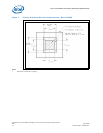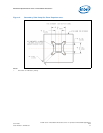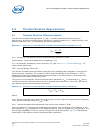
Intel® Core™ 2 Duo Mobile Processors on 45-nm process for Embedded Applications
June 2008 TDG
Order Number: 320028-001 6
Introduction—Core™ 2 Duo Mobile Processors
1.0 Introduction
The power dissipation of electronic components has risen along with the increase in complexity of
computer systems. To ensure quality, reliability, and performance goals are met over the product’s life
cycle, the heat generated by the device must be properly dissipated. Typical methods to improve heat
dissipation include selective use of airflow ducting, and/or the use of heatsinks.
The goals of this document are to:
• Identify the thermal and mechanical specification for the device.
• Describe a reference thermal solution that meets the specifications.
A properly designed thermal solution will adequately cool the device at or below the thermal
specification. This is accomplished by providing a suitable local-ambient temperature, ensuring
adequate local airflow, and minimizing the die to local-ambient thermal resistance. Operation outside
the functional limits can degrade system performance and may cause permanent changes in the
operating characteristics of the component.
This document describes thermal design guidelines for the Intel® Core™ 2 Duo Mobile Processors on
45-nm process for Embedded Applications in the micro Flip Chip Pin Grid Array (micro-FCPGA)
package and the micro Flip Chip Ball Grid Array (micro-FCBGA) package. The information provided in
this document is for reference only and additional validation must be performed prior to implementing
the designs into final production. The intent of this document is to assist each original equipment
manufacturer (OEM) with the development of thermal solutions for their individual designs. The final
heatsink solution, including the heatsink, attachment method, and thermal interface material (TIM)
must comply with the mechanical design, environmental, and reliability requirements delineated in
the processor datasheet. It is the responsibility of each OEM to validate the thermal solution design
with their specific applications.
This document addresses thermal and mechanical design specifications for the Intel Core 2 Duo
processor only. For thermal design information on other Intel components, refer to the respective
component datasheets.
1.1 Design Flow
Several tools are available from Intel to assist with the development of a reliable, cost-effective
thermal solution. Figure 1 illustrates a typical thermal solution design process with available tools
noted. The tools are available through your local Intel field sales representative.


















